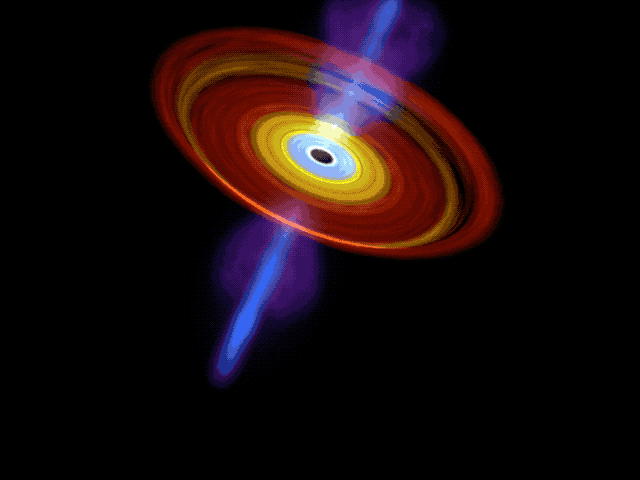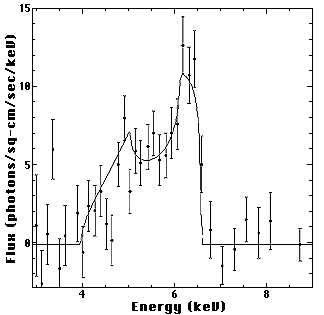ASCA Special Exhibit
Relativistic accretion disks in active galactic nuclei
Active galactic nuclei, or AGN for short, are believed to contain a massive black hole surrounded by an accretion disk. While there have been successes in imaging the inner regions of AGNs (notably using the Hubble Space Telescope), it is still not possible to take a close-up picture of their inner regions. Scientists believe that the X-ray emission line data obtained with ASCA proved the presence of a relativistic accretion disk.

This animation shows the energy levels of two different points on the accretion disc of a spinning black hole.
Emission line photons have a specific energy (or wavelength, or frequency), dictated by the atomic physics, as seen from the matter that emitted them. When the emitting matter is moving, then we detect the photons at Doppler shifted energies. In an accretion disk, material near the outside moves slower than material in the inner parts. Depending on the angle at which we observe the accretion disk, and ignoring relativistic effects for now, emission lines from an accretion disk have a characteristic double-horned structure.

Spectrum from a four-day observation of an AGN called MCG -6-30-15. The spectrum showed the "double horn" structure for the first time and providing strong evidence for an accretion disk around the central black hole in these galaxies. (Credit: Tanaka et al, Nature (1995) 375:659)
When the accretion disk surrounds a black hole, however, the relativistic effect must also be considered. Photons coming from close to the black hole (those that are also at extreme wings in the non-relativistic case above) are gravitationally redshifted, introducing a characteristic distortion. This is exactly the model that fits the iron emission line data on several AGNs observed with ASCA, first demonstrated in a four-day observation of the Seyfert galaxy MCG-6-30-15.
This result is a convincing demonstration of a relativistic accretion disk surrounding a massive black hole. Indirectly, but surely, we were observing the regions very close to the central black hole with ASCA data. Moreover, with further high-quality data, we can hope to constrain our viewing geometry and whether (or how fast) the central black hole is rotating.
Published: February 1998
Text Reviewed: September 2018


